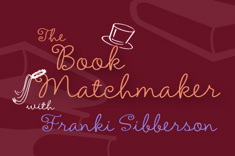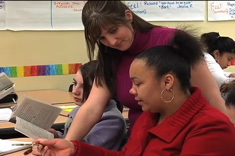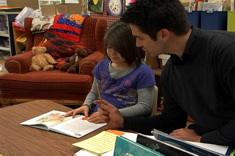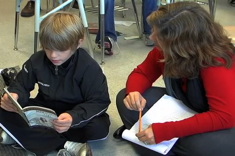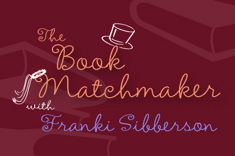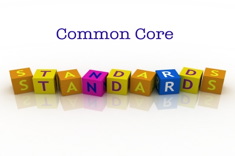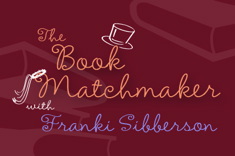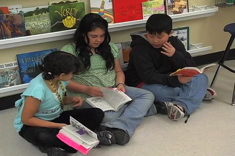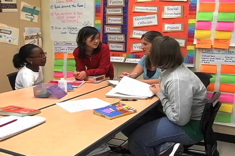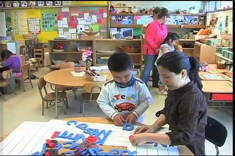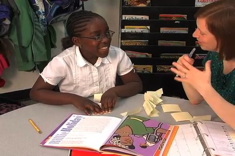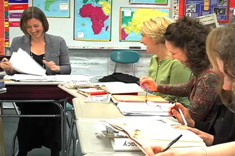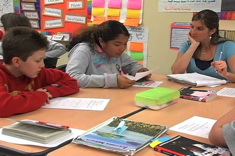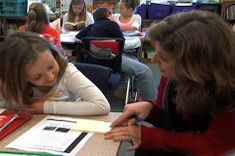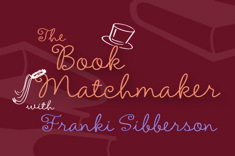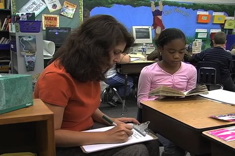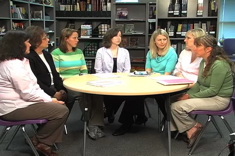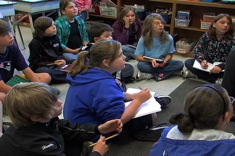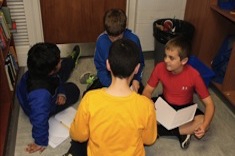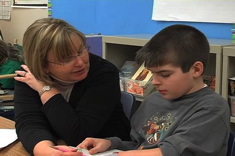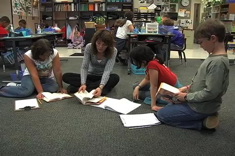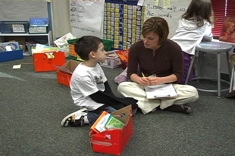Teaching Reading
Our contributors lead reading workshops in classrooms with creative flair. Over the past 12 years, we've filled our site with loads of suggestions, tools, and tips for using engaging books throughout the curriculum to hook kids on reading. Here is where you will find many stories of successful and not-so-successful workshop days, and what we learned from them. We bring these stories to life through hundreds of video examples.
Latest Content
Book Matchmaker: Global Citizenship and Social Responsibility
Here are some newer books for teaching students about social responsibility and what it means to be a citizen of the world.
“And Then and Then and Then”: Moving Students from Retelling to Thoughtful Response
Katie Doherty confers with sixth grader Kristina during reading workshop. Kristina is new to the classroom, and Katie demonstrates how to gently move a student from retelling to more thoughtful responses to literature with a few simple and carefully worded questions.
Conferring About Chunking Words in Second Grade
Sean Moore confers with a 2nd grader who is learning the strategy of chunking words in reading. Notice how Sean focuses the student, refers to previous conferences, and previews an upcoming whole-class reading.
Stop and Track: Conferring with a Fifth-Grade Reader
In this conference with a 5th grader, Aimee Buckner shares two strategies — one to use when putting a book away between readings, and another to help keep track of characters in a complex narrative where the point of view is constantly shifting.
Book Matchmaker: Picture Book Biographies
Franki Sibberson shares some of her favorite picture book biographies in the latest installment of Book Matchmaker.
Common Core Conversations: Text Complexity
Amanda Adrian and Heather Rader find ways into understanding text complexity with students and teachers.
Book Matchmaker: Wordless Picture Books
Brad Smedley, an elementary principal, is looking for wordless picture books to share with his preschool classes.
Middle School Book Clubs: Introduction
Katie Doherty explains why she has book clubs with her 6th grade students.
Fresh Books and Age-old Skills
Suzy Kaback provides a booklist of newer texts that can be used to teach multiple reading strategies.
Middle School Book Clubs: Response Options
Students have different response options in Katie Doherty’s sixth grade book clubs.
Preschool Centers
Centers can be an effective teaching and learning strategy in preschools. In this video, Melissa Kolb shares her rationale for using centers in her Head Start classroom with video examples of centers.
Sticky Notes to Determine Importance
In this conference from Beth Lawson’s third-grade classroom, the focus is on the skill of determining importance in texts. Beth helps Sephina integrate sticky notes into her strategic reading of the book The Blues Singers.
Inferring and Synthesis: Conferring Over Series Books
Beth Lawson shows how to get the most from a conference about series books in 3rd grade. Inferring and synthesis are discussed, as well as the use of written notes for making meaning from texts.
Beyond Harry Potter: Tapping Student Interest in Fantasy
Franki Sibberson taps into the fantasy craze among students with this booklist.
Planning for a Demonstration Lesson Part 1
In this first installment of a video series, Clare Landrigan takes a team of grades 3-5 teachers through the steps of planning for a demonstration lesson.
Guiding a Struggling Middle School Book Club
What do you do about those book clubs that just don’t jell in your middle school classroom? Katie Doherty demonstrates how she guides a struggling group of sixth graders, helping them reflect and converse together.
Planning for a Demonstration Lesson Part 2
In this second installment of a two-part video series, Clare Landrigan takes a team of grades 3-5 teachers through the steps of selecting a book for a demonstration lesson.
Main Ideas, Summaries, and Notes in a Reading Conference
In this conference with a fourth grader, Aimee Buckner tackles text choice, notes, and main ideas all in less than five minutes. You’ll notice teachers observing in the background; the conference is part of a demonstration lesson sequence.
Book Matchmaker: Teaching Theme in the Intermediate Grades
Students need strong mentor texts for understanding the concept of theme. Franki Sibberson shares many of her favorites in this Book Matchmaker.
Synthesis in Reading and the Reading Notebook
Beth Lawson helps one of her 3rd grade students write in response to a complex text he is reading, talking through how the writing might help him synthesize the plot of the story.
Conferring About Rereading Strategies
In this conference with a fourth grader, Aimee Buckner guides a child to think more deeply and critically about a book being read to the whole class, Goblins in the Castle.
Second-Grade Team Meeting: Helping Students Choose Books Independently
In this five-minute excerpt from a second-grade team meeting, Principal Karen Szymusiak sits in on a discussion about the challenges of helping young readers learn to pick appropriate books independently.
Guided Reading in Perspective
Cathy Mere puts guided reading in perspective, explaining how it works as one piece of the puzzle when it comes to fostering a lifelong love of reading in students.
Setting the Stage for Historical Fiction
In this demonstration lesson from a fifth-grade classroom, Aimee Buckner works with students to construct an anchor chart for understanding the genre of historical fiction.
Grades K-2 Fluency Lesson
In this video from a K-2 multiage classroom, Joan Moser and Gail Boushey ("The Sisters") present a fluency lesson to the whole class.
Conferring with Tweens: Nastia
Katie Doherty confers with Nastia, a 6th grade English language learner who is working on her inferring skills.
Grouping: Who? How Big? How Often?
In this first installment of a series on grouping, Heather Rader considers size, composition, and frequency.
Reading Conferences in 5th Grade
Karen Terlecky confers with her 5th graders during reading workshop.
Launching a Book Club in 4th Grade
In this video from Andrea Smith’s 4th grade classroom, students get organized for a small group author study of Andrew Clements.
Helping Young Readers Become Independent
Teachers speak often about the importance of helping students become independent, but what does that look like in practical terms? Katie DiCesare considers her interactions with Evan, an emergent reader, on the road to independence.
Browse Content By
Type
Category
- Assessment Tools
- Big Fresh Archives
- Booklists
- Choice Numeracy
- Classroom Design
- Common Core
- Community Building
- Conferring
- Content Literacy
- Digital Literacy
- English Language Learners
- Equity
- Family Relations
- Free Samples
- Guiding Groups
- Leadership
- Literacy Coaches
- Mentor Texts
- Minilessons
- New Teacher Mentors
- Podcasts
- Poetry
- Quote Collections
- Reading Strategies
- Self Care
- Struggling and Striving Learners
- Talking and Listening
- Teacher Study Groups
- Teaching Reading
- Teaching Writing
- Word Study and Vocabulary
Author
- Melissa Quimby
- Nawal Qarooni
- Gwen Blumberg
- Julie Cox
- The Lead Learners
- Hannah Tills
- Josie Stewart
- Ruth Metcalfe
- Mallory Messenger
- Becca Burk
- Jodie Bailey
- Vivian Chen
- Mary Brower
- Tiffany Abbott Fuller
- Stephanie Affinito
- Ruth Ayres
- Leigh Anne Eck
- Heather Fisher
- Shari Frost
- Julie Johnson
- Suzy Kaback
- Gigi McAllister
- Shirl McPhillips
- Melanie Meehan
- Cathy Mere
- Debbie Miller
- Tara Barnett and Kate Mills
- Tammy Mulligan
- Dana Murphy
- Bitsy Parks
- David Pittman
- Brenda Power
- Heather Rader
- Matt Renwick
- Mandy Robek
- Christy Rush-Levine
- Gretchen Schroeder
- Jen Schwanke
- Brian Sepe
- Katherine Sokolowski
- Stella Villalba
- Jennifer Vincent
Grade Level
Choice Literacy Membership
Articles
Get full access to all Choice Literacy article content
Videos
Get full access to all Choice Literacy video content
Courses
Access Choice Literacy course curriculum and training

